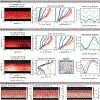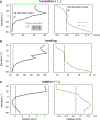Optic flow in the natural habitats of zebrafish supports spatial biases in visual self-motion estimation
- PMID: 36327979
- PMCID: PMC9729457
- DOI: 10.1016/j.cub.2022.10.009
Optic flow in the natural habitats of zebrafish supports spatial biases in visual self-motion estimation
Abstract
Animals benefit from knowing if and how they are moving. Across the animal kingdom, sensory information in the form of optic flow over the visual field is used to estimate self-motion. However, different species exhibit strong spatial biases in how they use optic flow. Here, we show computationally that noisy natural environments favor visual systems that extract spatially biased samples of optic flow when estimating self-motion. The performance associated with these biases, however, depends on interactions between the environment and the animal's brain and behavior. Using the larval zebrafish as a model, we recorded natural optic flow associated with swimming trajectories in the animal's habitat with an omnidirectional camera mounted on a mechanical arm. An analysis of these flow fields suggests that lateral regions of the lower visual field are most informative about swimming speed. This pattern is consistent with the recent findings that zebrafish optomotor responses are preferentially driven by optic flow in the lateral lower visual field, which we extend with behavioral results from a high-resolution spherical arena. Spatial biases in optic-flow sampling are likely pervasive because they are an effective strategy for determining self-motion in noisy natural environments.
Keywords: natural scene statistics; optic flow; self-motion.
Copyright © 2022 The Author(s). Published by Elsevier Inc. All rights reserved.
Conflict of interest statement
Declaration of interests The authors declare no competing interests.
Figures







Comment in
-
Motion vision: Fish swimming to see.Curr Biol. 2023 Jan 9;33(1):R30-R32. doi: 10.1016/j.cub.2022.11.027. Curr Biol. 2023. PMID: 36626861
References
-
- Serres JR, and Ruffier F (2017). Optic flow-based collision-free strategies: From insects to robots. Arthropod Struct. Dev. 46, 703–717. - PubMed
-
- Srinivasan MV (1992). How bees exploit optic flow: behavioural experiments and neural models. Phil. Trans. R. Soc. Lond. B 337, 253–259.
-
- Esch HE, Zhang S, Srinivasan MV, and Tautz J (2001). Honeybee dances communicate distances measured by optic flow. Nature 411, 581–583. - PubMed
-
- Barron A, and Srinivasan MV (2006). Visual regulation of ground speed and headwind compensation in freely flying honey bees (Apis mellifera L.). J. Exp. Biol. 209, 978–984. - PubMed
Publication types
MeSH terms
Grants and funding
LinkOut - more resources
Full Text Sources
Molecular Biology Databases

